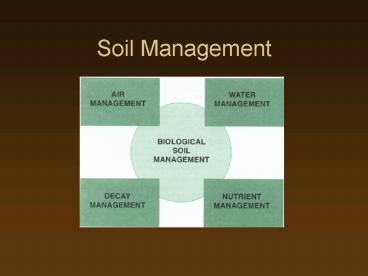Soil Management - PowerPoint PPT Presentation
1 / 27
Title:
Soil Management
Description:
Sand (gravel consists of elements over 2 mm) Silt (.05 - .002 mm) Clay ... Coarse sand - half dollar. Fine clay - basketball court. Soil Components. Composting ... – PowerPoint PPT presentation
Number of Views:41
Avg rating:3.0/5.0
Title: Soil Management
1
Soil Management
2
Weathering
3
Soil formation
- There are five main groups of soil forming
factors - climate
- vegetation
- parent material
- type of relief
- time the soil has been forming under the
influence of the various factors
4
Soil Profiles
- General soil profile
- Letters represent horizons
- Numbers are layers within those horizons
- Code
- 0 litter
- A Topsoil area of leaching and organic matter
accumulation - B Subsoil area of accumulation
- C parent material
- R bedrock
5
(No Transcript)
6
(No Transcript)
7
Litter build up
- Climate effects the amount of litter and humus
found in an ecosystem.
8
Components of soil
- Sand (gravel consists of elements over 2 mm)
Silt (.05 - .002 mm)
Clay (less than .002 mm)
Humus
A more or less biologically stable, dark,
amorphous material formed by the microbial
decomposition of plant and animal residues."
9
(No Transcript)
10
Surface areas
- Approximate surface areas of 1 gram samples
- Coarse sand - half dollar
- Fine clay - basketball court
11
Soil Components
12
Composting
- Decomposition process
- Grass, leaves, kitchen waste (no meat products),
plant clippings - Heat build up kills undesirables
- Dont include weeds
- Compost bin speeds up process
13
Compost Bin
- A wire or wooden bin should be constructed
- Refuse is placed on the bottom 6 to 9 inches deep
- Sprinkle a high nitrogen fertilizer over the top
of the material - Cover with a thin layer of soil (to supply
microorganisms) - Wet slightly
- Continue the layering process until the bin is
full
14
(No Transcript)
15
(No Transcript)
16
Maintaining
- Bin should be kept damp by sprinkling and should
be turned about every 4 weeks. - Special tools are also available for aerating
- should not replace the turning because they do
little for heat distribution.
17
Organic Matter in Soil
- Benefits of Organic Matter
- Improves aggregation and structure
- Improves infiltration
- Improves water holding capacity
- Improves rooting environment
- Slow-release nutrients
18
Animal Manure
- Fresh manure can contain human pathogens.
- Salmonella, E. coli, etc.
- Vegetables eaten fresh have greatest risk.
- Pathogens die off in the environment.
19
Using Manure Safely
- Incorporate manure into soil before planting.
- Wait AT LEAST 120 days between application of
fresh manure and harvest. - Well aged (? year) and thoroughly composted
manure do not have pathogen risk. - Dont use cat, dog or swine manure.
20
Application
- Organic application guidelines (Middle-of-the
road estimates) - Poultry manure, rabbit manure 1-2 gal/10 sq. ft.
- Horse manure, dairy solids 1 inch
- Compost 1 inch per year in annual bed
- Compost Up to 30 to 50 by volume when making
raised beds.
21
Grow Your Organic Matter
- Green Manure or Cover Crops
- Grow your own Organic Matter
- Legumes will provide N
- Cover crop during the winter
- Early planting is best
- Soil incorporation takes work
22
Soil pH
- Soil Acidity Affects
- Availability of nutrients
- Availability of toxic metals
- Microbial activity
23
(No Transcript)
24
Desirable pH Ranges
- Garden vegetables 6 to 7.5
- Lawns 5.5 to 7
- Acid loving plants 4.5 to 5.5
25
Increasing pH
- Lime (CaCO3) neutralizes acidity
- Lime supplies Ca, which is often deficient in
acid soils - Dolomite lime also supplies Mg
- Apply lime based on soil test, and lime only
those crops that need it. - For gardens without soil test 50 lb/1000 sq
ft/year
26
Decreasing pH
- Sulfur
- For gardens without soil test
- 10 to 20 lb S/1000 sq ft for sandy soils,
- 40 to 50 lb S/1000 sq ft for clayey soils
- Ammonium sulfate decreases pH slowly
27
(No Transcript)































